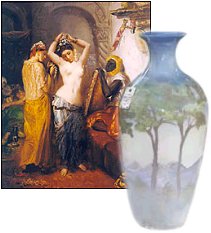Saturday, December 04, 2004
Cultural Theft

A story in this morning’s New York Times highlight’s the present danger of cultural theft with details of a bold daytime robbery at Adam Williams Fine Art Ltd., a small Manhattan art gallery.
Unless the criminals involved in this particular theft have a guaranteed resale in mind for their stolen Chassériau, they should find it difficult to turn a hot 19th Century Romantic into cold cash as the fine arts world is small and ever more highly, thanks to the world wide web, visible.
An article from this past week’s Antique Week reports that a painting stolen from a Taos, New Mexico dealer in April of 2003 was recently recovered shortly after it appeared in the listings of an October 26th live internet auction.
The recovery was credited to the Taos owner’s “dogged persistence” in hunting online venues for his stolen painting.
Aspiring criminal minds might want to stick with high end TV’s and DVD players as the penalties for cultural theft, recently modified in the US Criminal Code, are considerably more severe than penalties for ordinary theft.
Additionally and unlike easily resold mass-produced items, the value of artwork fluctuates in the marketplace.
The five-figure value of today’s stolen artwork could easily, by its recovery date, have appreciated in value and in cultural importance consequently enhancing the attendant criminal penalties.
The October 14th overnight break-in at the Ryding’s Rozart Pottery Studio in Excelsior Springs, MO is the largest theft of American Art Pottery in recent memory.
From my memory of an Antique Week story unavailable online, the perpetrators appeared to be quite familiar with the studio and storeroom from which the pottery was stolen.
The article quoted principals at the Ryding’s Pottery saying that the thieves picked over various shelves of stored pottery to select the most rare and valuable pieces.
The article suggested that police believed the thief to have “inside knowledge” of the Ryding’s studio.
The American Art Pottery Association maintains a list of stolen pottery that includes the Rozart theft and, amazingly, a still unrecovered Rookwood bowl taken during the preview of the June 2000 Spring Sale at the Cincinnati Art Gallery.
Serious collectors should utilize the Department of Justice and Interpol recommended Getty Object ID Checklist to describe lost or stolen artwork.
The Getty ID is an international standard for identifying cultural objects that was begun by the J. Paul Getty Trust in 1993 and internationally launched, with the assistance of major law enforcement agencies, including the FBI, Scotland Yard and Interpol; museum, cultural heritage, art trade and art appraisal organizations; and insurance companies, in 1997.
Unfortunately, as in the case of the Rozart thefts, a sticky-fingered “friend” or, likely in the case of the 2000 CAG theft and definitely in the case of the Iraq Museum thefts, a crazed and equally sticky-fingered collector could hinder most recovery efforts as the item could vanish into a private illicit collection for decades.
Images: New York Times, Rozart Pottery Studio

